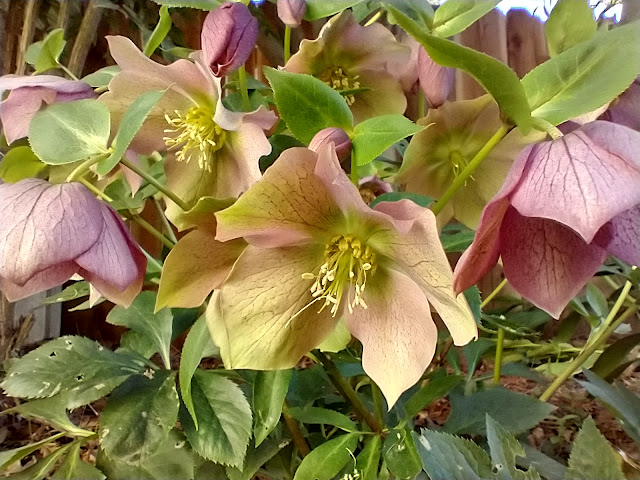
Hellebore is a great water-wise choice for hard-to-plant spot: dry shade

|
| Hellebores offer long-lasting blooms in dry shade. (Photo: Debbie Arrington) |
This “rose” blooms where (and when) others won’t. It flowers in dry shade – in late winter.
On March 2, the first day of Lent, my Lenten roses were in full flower. In shades from near black to creamy pale green, those interesting blooms actually arrived way early; they’ve been opening for most of February. But they’re so long lasting, they’ll still be around for Easter.
“Lenten rose” is the nickname for hellebore, a wonderful shade-loving perennial. Despite the nickname, they’re only a distant relative of roses. They’re actually close cousins to ranunculus.
Native to Southeastern Europe, hellebores are well adapted to our Mediterranean climate. Once established, they can get by with only twice-monthly irrigation, which makes them a great pick for water-wise landscapes.
Naturally compact, they love dry filtered shade, such as under trees. Hellebores can tolerate some sun, too; just not full Sacramento summer sun.
Their large, leathery leaves stay close to the ground, usually under 1 foot tall. In winter, they send up flower stalks with large bell-like blooms.
These plants are extremely low maintenance. Unlike roses, Lenten roses need no pruning. Just snip off any unattractive leaves in summer.
Another plus for hellebores: Deer don’t like them. Hellebores also can tolerate colder temperatures, making them ideal for foothill gardens.
New hybrids have expanded the range of hellebore colors and petal patterns, from pure white to darkest purple black. Most varieties fade to shades of pink or purple.
Two hybrid hellebores have been featured by the UC Davis Arboretum as part of its water-wise plant collections: Pink Frost ( Helleborus X ballardiae ‘Coseh 710’ ) and Mahogany Snow ( Helleborus X ballardiae ‘Coseh 930’ ).
Pink Frost has striking cream-colored flowers with pretty pink edges that last for weeks in the garden. Mahogany Snow is similar with creamy petals reversed with dark pink. Those varieties and others can be seen in the arboretum’s Terrace Garden and Ruth Risdon Storer Garden.
Corsican hellebores, which have bright green flowers, are featured in the Arboretum’s White Flower Garden near the gazebo.
See them in bloom now. For more information, visit the arboretum’s website: https://arboretum.ucdavis.edu .
Comments
0 comments have been posted.Sacramento Digs Gardening to your inbox.
Food in My Back Yard Series
May 6: Maintain soil moisture with mulch for garden success
April 29: What's (already) wrong with my tomato plants?
April 22: Should you stock up on fertilizer? (Yes!)
April 15: Grow culinary herbs in containers
April 8: When to plant summer vegetables
April 1: Don't be fooled by these garden myths
March 25: Fertilizer tips: How to 'feed' your vegetables for healthy growth
March 18: Time to give vegetable seedlings some more space
March 11: Ways to win the fight against weeds
March 4: Potatoes from the garden
Feb. 25: Plant a fruit tree now -- for later
Feb. 18: How to squeeze more food into less space
Feb. 11: When to plant? Consider staggering your transplants
Feb. 4: Starting in seed starting
Sites We Like
Garden Checklist for week of May 4
Enjoy this spring weather – and get gardening!
* Plant, plant, plant! It’s prime planting season in the Sacramento area. Time to set out those tomato transplants along with peppers and eggplants. Pinch off any flowers on new transplants to make them concentrate on establishing roots instead of setting premature fruit.
* Direct-seed melons, cucumbers, summer squash, corn, radishes, pumpkins and annual herbs such as basil.
* Harvest cabbage, lettuce, peas and green onions.
* In the flower garden, direct-seed sunflowers, cosmos, salvia, zinnias, marigolds, celosia and asters. (You also can transplant seedlings for many of the same flowers.)
* Plant dahlia tubers. Other perennials to set out include verbena, coreopsis, coneflower and astilbe.
* Transplant petunias, marigolds and perennial flowers such as astilbe, columbine, coneflowers, coreopsis, dahlias, rudbeckia and verbena.
* Keep an eye out for slugs, snails, earwigs and aphids that want to dine on tender new growth.
* Feed summer bloomers with a balanced fertilizer.
* For continued bloom, cut off spent flowers on roses as well as other flowering plants.
* Add mulch to the garden to maintain moisture. Mulch also cuts down on weeds. But don’t let it mound around the stems or trunks of trees or shrubs. Leave about a 6-inch to 1-foot circle to avoid crown rot or other problems.